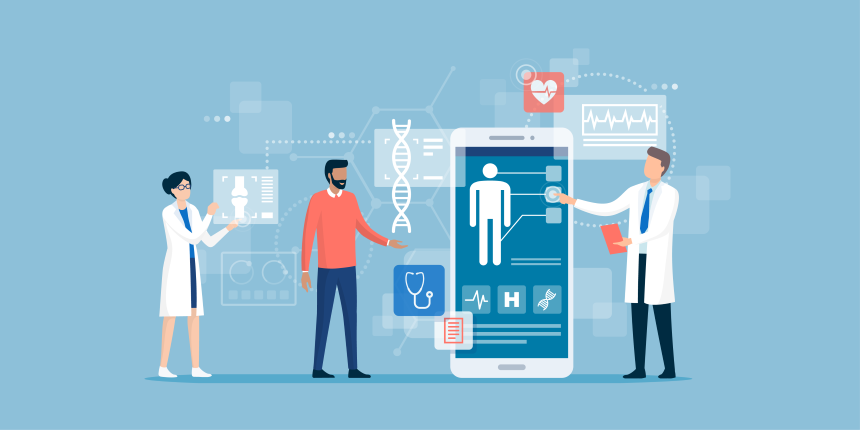AI Transcription for Contact Centers: What You Should Know
by Kent Mao | Published On January 12, 2024 | Last Updated March 6, 2025

AI can help convert speech to text and can be used to transcribe phone calls in contact centers.
Artificial intelligence (AI) is changing our daily lives. But did you know that it can help with call transcription too?
AI software tools can be used in call centers to convert voice calls and audio messages to written text. They can also highlight key parts of the call transcript and be used to generate insights such as customer sentiment and satisfaction.
Read on to learn what AI transcription is, the benefits of AI transcription over human transcription and how these tools can be leveraged in your contact center.
What is AI Transcription?
AI transcription is the process of converting speech – such as phone calls or video recordings – into text. This speech-to-text conversion can be done in real time or after the speech has been recorded.
AI transcription involves the use of automatic speech recognition (ASR) and machine learning algorithms to generate transcripts. Many AI-powered tools can help with transcription and they are quickly replacing human transcribers in a variety of applications.
Companies such as Google, Apple, and Microsoft have implemented AI transcription tools for various use cases, such as generating transcripts after a live call and creating subtitles for videos.
AI transcription applications in contact centers
- Record and transcribe all customer phone calls and interactions
- Search and analyze transcripts for useful data and insights
- Use call transcripts for agent training
- Provide agents with feedback on past calls and performance
- Store transcripts for legal purposes
AI vs Human Transcription
Before the introduction of call transcription software, phone calls had to be manually transcribed by humans.
This type of transcription is labor intensive and requires professionals to decipher important information and produce accurate transcripts. Human transcriptionists still exist and are utilized in industries that require an even higher degree of accuracy than AI offers, such as legal and medical fields.
But as AI tools become more advanced, many businesses are turning to them over humans for their transcription needs. AI transcription tools offer both speed and accuracy at lower costs, making the transcription process more efficient and cost-effective.
How Does AI Transcription Work?

The process of transcribing a phone call using AI software involves three main steps:
Speech recognition. AI transcription relies on automatic speech recognition (ASR) to process human speech into written text. The ASR technology must be able to filter out background noise, identify multiple speakers, and understand various dialects and accents.
Natural language processing. After ASR processes the speech into text, AI transcription software must then use natural language processing (NLP) to process the text and understand its meaning. This part can be challenging since humans often use complex phrases and abbreviations in their speech.
Transcript generation. Once the speech is converted to text and run through NLP algorithms to interpret its meaning, the final transcript is generated.
Benefits of AI Transcription
When compared to other methods of transcription, AI-powered tools have many advantages. Here are the major ones:
Speed
Businesses are always looking for ways to save time and increase efficiency. With AI-powered transcription, you can automate the transcribing process and drastically reduce the turnaround time. For example, while a long audio file might take several hours for a human to transcribe, AI software can produce a transcript within a few minutes.
Price
Along with speed, AI tools offer better cost-effectiveness. It’s not hard to understand why computer-powered transcription might be cheaper than humans. Thankfully, AI transcription tools are quite affordable – even for small businesses – and there are many options out there at different price points, too.
Accuracy
AI transcription products claim to be up to 99% accurate. But whether these numbers themselves are accurate is up for debate. In comparison, human transcribers have an average error rate of 4%.
Scalability
One of the major benefits of AI transcription is its scalability. Due to their automated nature, AI-powered tools can easily expand to handle high volumes of content, making it an ideal option for large organizations. Along with scalability, AI tools allow for greater levels of customization, which is essential for integrating the solution into your existing infrastructure.
Data and insights
Perhaps the greatest advantage of AI transcription is the in-depth data and insights that can be extracted from call transcripts. For example, AI tools can search transcripts to provide actionable feedback on how the customer felt about the interaction and what questions they had. Transcripts can also be used as a training tool by analyzing opportunities for agents to improve their performance.
Drawbacks of AI Transcription
While AI transcription offers many benefits, there are a few downsides to using this technology as well. As a result, it’s unlikely that AI will fully replace human transcribers in the near future.
Here are the main drawbacks of AI transcription tools:
Speech-to-text accuracy. AI transcription tools are prone to making mistakes in suboptimal conditions, such as when there are background noises or multiple people speaking. In these situations, human transcriptionists tend to perform better.
Complex understanding. Many AI tools struggle with accents, complex jargon or context-dependent phrases. For example, they may not understand sarcasm or cultural references, leading to errors in transcribing and interpreting the text. Human transcriptionists, on the other hand, are trained to decipher different accents and dialects. Humans are also better at understanding complex phrases.
Editing and quality control. In situations that require high levels of accuracy, humans are still relied on to edit and perform quality control on AI-generated transcripts. This is because – despite all their benefits – AI tools still require humans to review their output and make sure they are accurate.
AI Conversation Analytics for Contact Centers

New AI tools for conversation analytics have been in development for years and there are quite a few available on the market today. Popular software solutions include Tethr, Gong, and Chorus.ai.
These software solutions offer a variety of use cases for contact centers. AI conversation tools can be used to:
- Reduce costs and improve efficiency. AI analytics can be used to pinpoint the causes of lengthy calls, channel switching, and repetitive contacts.
- Prevent customer churn. AI analytics can help identify reasons for customer churn and highlight accounts that are at risk of being lost.
- Boost sales revenue. You can leverage AI tools to analyze your customer interactions, increase conversion rates and boost overall sales.
- Optimize agent performance. AI analytics provides a wealth of data that you can use to improve agent behavior and performance. They can also identify script violations so that you can correct them.
- Gather customer insights. One major benefit of AI tools is the ability to gather in-depth insights on customer frustrations, product issues and competitor mentions. For example, AI can be used to analyze customer sentiment by detecting key phrases and emotions during conversations.
Conversation sources for AI analytics tools are not limited to just phone calls. They can also include CRM, chat, email and survey responses.
How to Choose the Right Transcription Software
There are many AI transcription products on the market today. But how do you know which one is right for you? Here are a few factors to consider:
Accuracy
Although all transcription products claim to be highly accurate, some may be more accurate than others. It’s important to properly vet any software you plan to use by finding out the Word Error Rate (WER) and comparing it to industry standards. Both Google and Microsoft claim that their products have a WER of about 5%.
Data security
Contact centers handle large amounts of sensitive data, and it is important that call transcripts remain confidential. In the healthcare and legal industries, this data privacy is of utmost importance. It’s crucial that you review the data security practices of any transcription product you plan to use and make sure it is compliant with regulations, such as PCI-DSS and HIPAA.
Compatibility
Compatibility with your existing contact center and CRM software is an obvious consideration. Most contact center solutions already come with AI transcription and analytics features. But if they don’t for some reason, make sure the solution you choose can integrate seamlessly with your existing infrastructure.
Summary
AI transcription is quickly replacing manual transcription due to its better speed and cost-effectiveness. While human transcription is still more accurate than AI, the accuracy rate of AI transcription tools continues to improve day by day.
Besides simply transcribing calls, AI-powered tools can be used to analyze customer interactions and gather in-depth insights. The industry for AI conversation analytics is quickly expanding with many software solutions now being offered.
Both transcription and conversation analytics tools can provide many benefits when implemented in a contact center. To learn more about ComputerTalk’s AI-enabled contact center, click here.
More from our blog
 In a society heavily impacted by a recent global pandemic, hospitals have been under a strain unlike any seen before in our lifetime. With this and the day-to-day strains of staff shortages and an aging population, the healthcare industry needs...
In a society heavily impacted by a recent global pandemic, hospitals have been under a strain unlike any seen before in our lifetime. With this and the day-to-day strains of staff shortages and an aging population, the healthcare industry needs...
 It’s finally here! We at ComputerTalk are excited to announce the general availability of ice Contact Center 11, our latest version.
It’s finally here! We at ComputerTalk are excited to announce the general availability of ice Contact Center 11, our latest version.
 My journey with ComputerTalk began in the fall of 2019. As a recent university grad, I was looking for my first full-time job and came across a Marketing position posted by ComputerTalk to my school’s job search platform. I applied...
My journey with ComputerTalk began in the fall of 2019. As a recent university grad, I was looking for my first full-time job and came across a Marketing position posted by ComputerTalk to my school’s job search platform. I applied...


